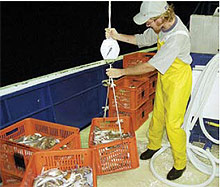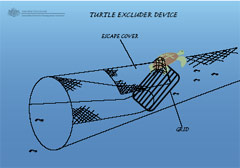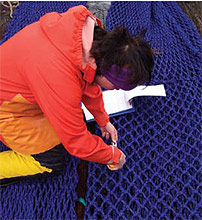
|
||||||||
|
Australian fisheries are working to reduce bycatch to avoid waste and keep marine resources healthy. By working together, fishers, makers of fishing gear, researchers, government and non-government organisations have introduced changes to fishing gear and practices that have reduced bycatch.
There is not a one size fits all solution to bycatch.
Solutions to bycatch require a range of approaches to suit the different fishing methods and bycatch species. The kind of bycatch species and how much is caught depends on how, when and where fishing takes place.
The chance of a certain species being caught as bycatch depends on whether the species lives in the area being fished (the fishery) and also whether it can get caught by the fishing technique being used.
Designing solutions to reduce bycatch requires an understanding of the fishery, the bycatch species and how they interact. Methods of reducing bycatch include modifying fishing gear or changing where, when and how people fish. The best way to reduce bycatch for a given species will depend on the fishery involved and the behaviour of that bycatch species. For example, oceanic longline fishing for tuna and billfish can occasionally catch marine turtles and seabirds. This rarely happens, but these species are at times attracted to fishing gear and baits and get caught on hooks or accidentally get tangled in fishing gear. All marine turtles and seabirds are protected under Australian legislation so fisheries must try to avoid catching them. One way to avoid seabirds is by scaring them away from baits using streamers that flap in the wind. One way to avoid marine turtles is by using types of bait which turtles prefer not to eat. Working together to develop solutions Fishers, fishing gear designers and manufacturers, researchers and government and non-government organisations all bring specialist knowledge to the development of solutions for reducing bycatch. |
 Skippers and crew members in the Northern Prawn Fishery help record information about bycatch for scientists and fishery managers. (courtesy CSIRO Marine and Atmospheric Research) |
Fishers (commercial, recreational and Indigenous) bring an understanding of how to efficiently catch their target species, how their gear works and what is practical and safe at sea. Fishers often design fishing gear and practises to reduce bycatch as it is in their interests to avoid catching non-target species. They also bring their observations and records of when and where they have caught bycatch.
 Diagram of a Turtle Excluder Device and Bycatch Reduction Device in a prawn trawl net. (courtesy AFMA) |
Fishing gear designers and manufacturers contribute by using their knowledge of how their gear works and the different materials that can be used. They can modify gear or design innovations to ensure the gear still catches the target species but not the bycatch. For example, changes to hook shape or net design can reduce bycatch. A good example of gear innovations is the incorporation of Turtle Excluder Devices (TEDs) into net designs used in tropical prawn trawl fisheries. TEDs allow prawns to enter a net yet prevent large marine animals like turtles from being captured. The device has proven to be highly successful in many fisheries around the world. |
Researchers understand or carry out research into the behaviour of bycatch species, where they live, how they change with the seasons and how the species respond to fishing gear. Economists can examine the costs or financial advantage of different ways to reduce bycatch - a crucial concern of fishers and managers alike. Additionally, gear technologists can measure how fishing gear behaves underwater and how changes to reduce bycatch can affect the way the gear works.
In Australia’s Northern Prawn Fishery for example, CSIRO Marine Research, the Bureau of Rural Sciences, and the Australian Maritime College have been researching bycatch for more than 10 years. The initial focus for the research was on TEDs. The focus in this fishery is now Bycatch Reduction Devices (BRDs) to reduce the unwanted catch of fish and invertebrates (such as crabs, shells, sea stars). Research is also being conducted into how best to monitor bycatch, and the likelihood or level of risk bycatch may affect the sustainability of animal populations or ecosystems. Researchers have worked with fishers and others to record and observe bycatch and to test the effectiveness of various TEDs and BRDs. |
 A Turtle Excluder Device in a prawn trawl net. (courtesy AFMA) |
Government agencies responsible for fisheries and the marine environment provide incentives and resources to undertake research and various trials to reduce and prevent bycatch. They also assist fishers to adopt the new gear and practices to reduce bycatch. Education campaigns and fisheries extension officers assist fishers to implement and use new gear. The Fisheries Research and Development Corporation (FRDC) funded projects identifying solutions to reduce bycatch for more than 15 years.
|
Non-government organisations provide resources and incentives to promote the development of solutions and assist fishers to put changes in place. OceanWatch Australia is an example of a national environmental, not-for-profit organisation that works to support sustainable management practices in the Australian seafood industry. OceanWatch Australia runs a national environmental extension service called SeaNet. SeaNet has been operating for over eight years and provides information and advice on reducing environmental impacts to fishers, and works directly with industry, managers and researchers to develop and implement new and improved fishing gear, technology and fishing methods. Another example of a non-government approach is the International Smart Gear Competition, created by the World Wildlife Fund. The competition is designed to inspire and reward innovative, practical and cost-effective ideas that allow fishers to fish ‘smarter’, so they can better target their intended catch while reducing bycatch. The 2006 winning idea was a novel approach to reduce shark bycatch in tuna and billfish longline fisheries by using rare-earth magnets on hooks. Australia has been successful in reducing bycatch in some fisheries because of the work these groups have done together. |
The future
It is important to keep looking for new and better ways to reduce bycatch, to benefit the fishing industry and the marine environment. We would li
Find out more
• Bureau of Rural Sciences – Fisheries and Marine Sciences:
www.daff.gov.au/fisheries_marine• CSIRO Marine and Atmospheric Research:
www.cmar.csiro.au• Oceanwatch Australia – SeaNet Environmental Extension Service:
www.oceanwatch.org.au• Fisheries Research and Development Corporation:
www.frdc.org.au• Smart Gear Comptetition:
http://www.smartgear.org/• Australian Maritime College:
www.amc.edu.au• Australian Fisheries Management Authority:
www.afma.gov.au• Department of Primary Industries, New South Wales – Fishing and aquaculture:
www.dpi.nsw.gov.au/fisheries• Department of Primary Industries and Fisheries, Queensland - Fisheries:
www.dpi.qld.gov.au/cps/rde/xchg/dpi/hs.xsl/28_ENA_HTML.htm• Department of Primary Industries, Victoria – Fishing and aquaculture:
www.dpi.vic.gov.au/dpi/nrenfaq.nsf• Primary Industries and Resources, South Australia – Fisheries:
www.pir.sa.gov.au/sector7.shtml• Department of Primary Industries and Water, Tasmania – Sea Fishing and aquaculture:
www.dpiw.tas.gov.au/inter.nsf/• Department of Fisheries, West Australia:
www.fish.wa.gov.au• Department of Primary Industries, Fisheries and Mines, Northern Territory - Fisheries:
www.nt.gov.au/dpifm/Fisheries
Acknowledgements
This information sheet has been complied using the expertise and support from a number of sources.
CSIRO Atmospheric and Marine Research; the Fisheries Research and Development Corporation (FRDC); The OceanWatch Australia website; Smart
Gear website.

